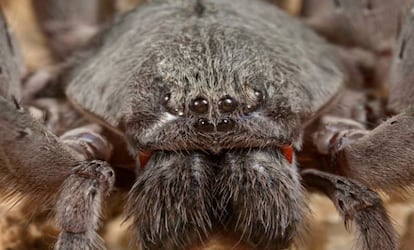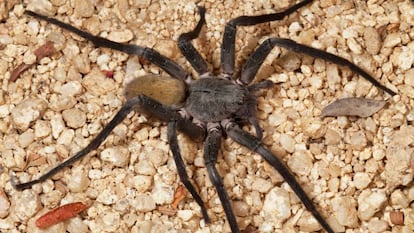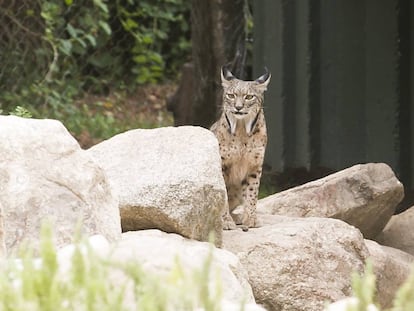New giant spider species discovered in northern Mexico
Arachnid is nearly the size of a tarantula, but its bite, while venomous, is not deadly to humans
Terrifying; intimidating; enormous. Such are the adjectives used to describe a new species of giant spider found in northern Mexico, in the state of Baja California Sur. It is nearly the size of a tarantula, lives in caves, has long, hairy legs, a yellow abdomen, huge fangs and four pairs of eyes that can stare down an adversary, as if to confirm that it will not be an easy prey. Investigators at the San Diego Natural History Museum, together with Mexican and Brazilian experts, have named it Califorctenus cacachilensis, or Sierra Cacachilas wandering spider.

“When I saw these spiders for the first time, I was very impressed by their size,” wrote the researcher María Luisa Jiménez, a spider expert from the Northwestern Center of Biological Research (CIBNOR), on the museum’s blog, where the discovery was announced. “In all my experience over the years collecting spiders on the peninsula, I had never seen a spider this large. I suspected that something new was waiting to be documented.”
A shed exoskeleton of the arachnid was first spotted in 2013 in the Cacachilas mountain range outside the state capital of La Paz. Researchers knew that wandering spiders are often nocturnal, and returned to the area. They found two dozen spiders inside a cave, in an abandoned mine and in the remains of a latrine.
I was bitten by one while I was working with it, and I’m still alive
Jim Berrian, researcher
Scientists collected eight specimens for research, and waited four years before confirming their find. After submitting their findings to peer review, they found that not only was this a new species, but a new genus altogether. The discovery was published in the March issue of the specialized magazine Zootaxa.
While their bite is venomous, researchers are ruling out that the wandering spider is deadly to humans. “I was bitten by one while I was working with it, and I’m still alive,” said Jim Berrian, one of the coordinators of the international team that made the discovery. Berrian noted that the venom’s toxicity has not been fully analyzed, but that everything indicates it is not as deadly as that released by its cousin from the Amazon, the Brazilian wandering spider.

While it is common for new species of spiders to be discovered every year, most are small and lack the impressive attributes of Califorctenus cacachilensis. The San Diego Natural History Museum blog notes that “most researchers estimate that there are two to five million insect and spider species that remain undocumented.”
English version by Susana Urra.
Tu suscripción se está usando en otro dispositivo
¿Quieres añadir otro usuario a tu suscripción?
Si continúas leyendo en este dispositivo, no se podrá leer en el otro.
FlechaTu suscripción se está usando en otro dispositivo y solo puedes acceder a EL PAÍS desde un dispositivo a la vez.
Si quieres compartir tu cuenta, cambia tu suscripción a la modalidad Premium, así podrás añadir otro usuario. Cada uno accederá con su propia cuenta de email, lo que os permitirá personalizar vuestra experiencia en EL PAÍS.
¿Tienes una suscripción de empresa? Accede aquí para contratar más cuentas.
En el caso de no saber quién está usando tu cuenta, te recomendamos cambiar tu contraseña aquí.
Si decides continuar compartiendo tu cuenta, este mensaje se mostrará en tu dispositivo y en el de la otra persona que está usando tu cuenta de forma indefinida, afectando a tu experiencia de lectura. Puedes consultar aquí los términos y condiciones de la suscripción digital.
More information
Archived In
Últimas noticias
The complicated life of Francesca Albanese: A rising figure in Italy but barred from every bank by Trump’s sanctions
How Japan is trying to avert ‘digital defeat’
Half of Scotland is in the hands of 420 property owners
Reinhard Genzel, Nobel laureate in physics: ‘One-minute videos will never give you the truth’
Most viewed
- Pablo Escobar’s hippos: A serious environmental problem, 40 years on
- Reinhard Genzel, Nobel laureate in physics: ‘One-minute videos will never give you the truth’
- Why we lost the habit of sleeping in two segments and how that changed our sense of time
- Charles Dubouloz, mountaineering star, retires at 36 with a farewell tour inspired by Walter Bonatti
- The Florida Keys tourist paradise is besieged by immigration agents: ‘We’ve never seen anything like this’










































